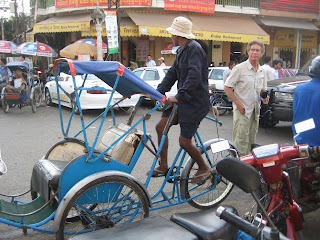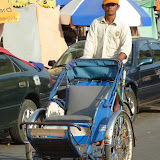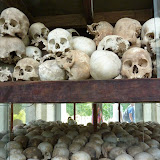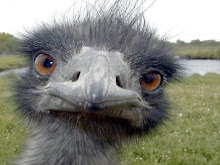CHRIS'S CAMBODIA BLURB
We arose at 5:15 am this Saturday morning to meet our tuk-tuk driver for sunrise at the breathtaking Angkor Wat 9th-13th century ruins near Seam Reap. Friday, after 8 hours of jaw-dropping but crowded exploration, we had requested that our driver, Chan, take us on Saturday to more remote ruins where there would be less people. It had been about 100 degrees F, so Chan’s canopied motorcycle-powered rickshaw offered steam-blasted but refreshing breezes as he hauled us among partially toppled Angkor temples. Today would be much better without the hordes of other tourists---mostly Korean, Chinese, and Japanese at this low season. We packed light bags with water, cameras, sunglasses and little else, since Chan would be returning us to our hotel for breakfast by 9:00 am.
How Not to RUIN a Good Day
It didn’t seem like he was going the right direction. But we couldn’t stop gawking as Chan spurted the tuk-tuk through throngs of shanties, past people bathing on their porches, naked toddlers, small village repair shops, women scaling fish, bicycles stacked 7-feet high with greens and vegetables, families having breakfast together on their porches, hammock-filled front rooms visible to the street, people sweeping dusty entryways with bramble brooms….Who cared where Chan was taking us!? Our eyes were brim full of Cambodia already. And this was still before sunrise.
After 40 minutes or so and still putting down country roads, we realized that our plan had been lost in translation. Chan was now in charge with no ruins in sight. So much for photo ops of carved templesides at dawn. Don and I laughed and decided to see what Chan had in mind. He spent the next hour driving us through villages, rice paddies, lotus blossom fields, and bustling early-rising Cambodian families. People waved at us as we passed the brown river flowing nearby, dumping buckets of water over their heads as they bathed on their front porches. Soon Chan stopped, and motioned us out of his vehicle. He directed us onto a 25-foot wooden-carved sloop. A few brightly cushioned wooden chairs beckoned us onboard, and the barefooted crew revved up the motor. Off we went. To where? Well, ultimately they navigated us up a shallow river to Tonle Sap, the “great lake” of Southeast Asia. Along the shallow water channel, we glimpsed floating villages and churches, temples, and intimate views of families living in wooden and woven houseboats with square footage totaling the size of an average American master bathroom. Most of us have seen pictures of these vessels on TV documentaries or in National Geographic, but to suddenly float by as the family is awakening or breakfasting or cutting vegetables, all in this tiny space, is amazing. We were sometimes one foot from their hammocks swinging on the decks or inches from their steaming bowls of morning noodles. A young girl leaned over her family’s houseboat to brush her teeth in the tepid, muddy water. All was neat and in order, with bare-bottomed toddlers playing on decked flooring alongside older siblings, mothers feeding their children or doing laundry in large aluminum basins, and young girls scooping buckets of water from the lake. At this time of year, the water level is extremely low in anticipation of the monsoon. On land, we glimpsed woven houses on 15-foot stilts. Chan said that in a month or so, the people who lived there would be using boats to do their errands, while now the earth around the homes is sun-baked hardpack. Most of the huts are built in a small valley so it is easy to imagine how they would look surrounded by swollen waterways. During some of the journey upriver, our 2-man crew hoisted our boat’s propeller out of the water, spraying thick brown sludge through the wake where the channel was especially shallow. As we passed small boatloads of families, fisherpersons and miscellaneous errand-doers , our crew was careful not to spatter waveloads of bottom sludge into their crude boats. We could peer at them just as easily as they could spy on us, negotiating inches from one another. If I smiled, they would smile back. Some children waved, and others nursed from their mothers or snuggled in their fathers’ laps. We eventually stopped at a floating restaurant for drinking water and tea, and of course the ubiquitous crafts for sale. The boat trip home was just as interesting under full beating sun. We re-boarded our tuk-tuk and Chan smiled broadly as he drove us back to Siem Reap. On the way, he showed us plastic trapping contraptions to gather crickets. At first I thought the purpose was to control insect pests, but later I realized that the traps are for collecting crickets to sell for eating! Don and I finally returned to our hotel just in time for breakfast, having relinquished the shaped tower images we had meant to capture in the early morning light in exchange for more than we ever imagined.
Tuk-tuks, Tap-taps, Guaguas, Pulmonias, Motos and Rickshaws
Speeding along with Chan in our tuk-tuk, we can sniff the breeze and calculate the weather on our shoulders. It brings to mind the methods of varied travel I have experienced in other countries. Open air is always a great way to travel, although motor car fumes, fires alongside the road, dust and humidity can combine for the worst badhair day imaginable. A long scarf, sunglasses and hat are imperative. Many residents in Cambodia and China wear surgical masks, and I can understand why. A motorless rickshaw seems like a better green alternative. I have traveled by human-pedaled bicycle rickshaws in China, New York City and India. The proximity of a sweating, toiling driver on a bicycle rickshaw can be intimidating, and I am not so comfortable with this mode because it makes me feel guilty. I find myself worrying about the driver’s tattered pants or the stains on his cuffs or his dusty sandals, when I prefer to be focusing on the sights. Perhaps this is as it should be, so that I will better appreciate all that I have, and honor the hard work of others who are providing for themselves and their families through great exertion. In contrast, the pulmonias of Mazatlan (called pulmonias because you can contract pneumonia by riding in them…supposedly) are a glitzy version of a golf cart, often decorated with pom-poms and crucifixes. However, I know that those Mexican drivers often work 15-hour shifts ,catnap in their pulmonias, and endure nauseating fumes, bumpy roadways and clueless tourists. The wildly painted tap-taps of Haiti in which we rode during the 1970s were packed with people, as they still are today. There exist many other modes of transport and shared rides such as Puerto Rican publicos and gua-guas (buses), and even commercial trucks and hay wagons in India and Turkey, where one can pay a driver to hang on the back, or even buy a portion of the front cab if lucky. Dominican motos provide motorcycle rides to whole families, as well as tourists rushing to the airport. Pedaled bicycles are the most basic option; I have observed families of four loaded onto a single bicycle, pedaled by the father, some with high-heeled wives and children lashed between satchels and bundle, while cars turn in front of them as they veer efficiently to the side. No matter the country, there seem to be numerous ingenious and delightful ways to get around.
Where We Got To
We negotiate our price for our excursions with Chan. Yes, he is ours for the whole day for $15 US. He will take us wherever we desire from sunup to sundown, and wait for us two or three hours while we traipse over baked ruins. And when we return, he opens his bag and pulls out two small watermelons. He takes them over to a woman at the side of the road who cuts off the outer shell and shapes the dripping sweet fruit onto wooden sticks. Chan presents us our watermelon using both hands, to show us respect, and to offer us whatever he is giving from the heart. All things are passed this way in China and Cambodia, even hotel receipts, loaned umbrellas, or change. Chan tells us the watermelons are small this year from lack of rainfall. But they are refreshing and flavorful. We thank him not only for the watermelon, but for the spontaneous and rich journey by tuk-tuk that we would be incapable of inventing on our own.
***********************************************************************************
DV's VolkVenture Cambodia TravelVlog:
Since Chris has written all of the intriguing Cambodia characterizations, I will proceed with an outline of travel for our Cambodia portion with links to our combined photo albums.
DV's VolkVenture Cambodia TravelVlog:
Since Chris has written all of the intriguing Cambodia characterizations, I will proceed with an outline of travel for our Cambodia portion with links to our combined photo albums.
We flew from Xi'an to Gouangzhou [former Canton] and as I predicted someone tried to smoke on the flight! Didn't last long and better than the complete smoke filled bar car on our train a couple nights before. The 3 hr. layover made us a couple hours late arriving at Siem Reap in Northern Cambodia.
Getting out of China proved more difficult than getting in. The problem was my baggy of vitamins and aspirin and then ¼ oz of hand sanitizer that just about put them over the edge! At least 6 people had to come and analyze and comment. They finally let me go.
Siem Reap is the destination for experiencing the ancient temples of Angkor. The Cambodian empire of the Khmer which dominated SE Asia from the 9th to 13th century was centered near Siem Reap, a vast complex of cities and temples. The entire complex may have been more than 1000 sq. km. with more than 1 million inhabitants. Only the Mayan city of Tikal in Guatemala, comes close to this size and was probably only a quarter of the size of Angkor. The mid 1300's saw the Empire collapsing from both pressure from regional warring neighbors to possibly the same sort of natural disasters and drought that led to the collapse of the Mayans during the same time, a half a world away. Not until the late 19th century were the ruins “rediscovered.” Restoration is still taking place. The days of our visit did not lead to inspirational encompassing views of the great centerpiece, Angkor Wat, but we did manage to show how the trees [started from seeds from bird droppings] have grown up through and around the temples helping reduce them to a shadow of their former selves.
Angkor Wat
Siem Reap, itself has become a tourist destination because of Angkor Wat with more than 100 hotels but still carries some great charm and intrigue:
After a few days in Siem Reap we had planned to take a ferry down Tonle Sap, SE Asia's largest lake, then the Tonle Sap river and float into Phnom Penh. But at this time, the end of the dry season, the lake is low and it cannot be navigated by larger boats. The rainy, monsoon season is about to start and with that, the melting glaciers that feed the mighty Mekong river will swell that river so much that the water will back up into Tonle Sap, [they converge in Phnom Penh] expanding it by four times. We were able to take a short boat ride down a small contributary after arriving in Phnom Penh to the edge of Tonle Sap to visit a houseboat village. Kind of reminds me of where our good friends, Gary and Linda Oman used to live on Lake Union in Seattle:
The 6 hour bus ride to Phnom Penh was intriguing with a lunch stop for some crickets and banana leaf wrapped rice and coconut goodies.
Phnom Penh, Phnom Penh, what a city, what a flashback? Do you remember the sixties and seventies? Now home to more than 2 million people, remember that Pol Pot and his Khmer Rouge totally evacuated this city back in 1975 and destroyed most of it, and sent the people to refugee camps throughout the country. These people have gone through hell, but the mere existence of what some of them have not is so much better than before. Modern day Phnom Penh is a zoo of sorts with it's narrow jam-packed streets, fascinating foods and markets:
Fifteen km outside of Phnom Penh is the Choeung Ek Genocidal Center [the infamous Killing Fields!] now the most significant memorial to the near 3 million Cambodians who met their fate under the near 5 year reign of the nasty Khmer Rouge. This is only one of 343 killing fields or burial sites throughout Cambodia. Not everyone died of violence as they did at Cheoung Ek, as others died of starvation and disease related to their situation. I purposely spared the details and photos of those. Sorry about the ones I did not omit.
Tuol Sleng or S-21 prison is within Phnom Penh [previously a high school] where more torture was carried on. Thousands of the tortured were eventually taken away to the killing fields of Choeung Ek:
We'll move on to Thailand now, wondering about the Bangkok unrest and whether or not we will go there as scheduled. But first, a retreat to the islands and beaches of Southern Thailand.
Stay tuned!
















